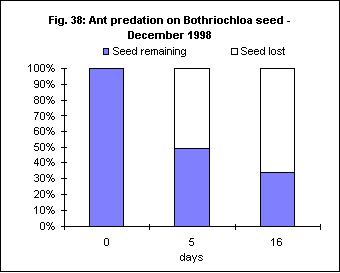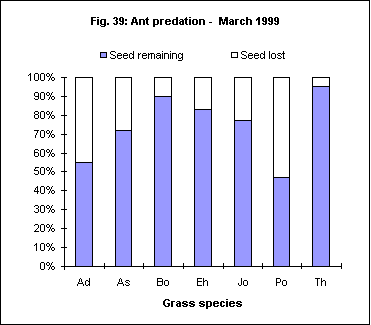![Director of National Parks [logo]](/images/dnp_90px.gif)


![Director of National Parks [logo]](/images/dnp_90px.gif) |
 |
 |
Granivory is a significant problem if the seed is not buried when sown. This is demonstrated by two trials on Mt Painter in the summer and autumn of 1998-99, which specifically investigated ant or other predation. In the first trial 20 intact Bothriochloa macra seeds were placed in each of 5 plastic petri dishes (90mm diameter). The dishes had an aperture cut in the side to allow the access of insects. The dishes were then placed in a corner of the same quadrat frames used for the first establishment trial (see below). Overall there was a loss of two thirds of the seeds within 16 days. For individual dishes the losses ranged from 10 to 100% (Fig. 38).

In a second trial in late March at the same site 20 intact seeds of each of seven species of grass were placed in petri dishes under the quadrat frames used for the second establishment trial (see below). Again there were five replications. Loss of seed ranged from 5% (Themeda triandra) to 53% (Poa labillardieri) after 5 days (Fig.39). Losses from individual dishes ranged from 0 to 100%, with an average loss of 25%.

(Key: Ad = Austrodanthonia caespitosa, As = Austrostipa scabra, Bo = Bothriochloa macra, Eh = Ehrharta, Jo = Joycea pallida, Po = Poa labillardierei, Th = Themeda triandra (species as per introduction))
Seed removal by ants (and other insects or birds) is a significant problem, especially if seed does not germinate quickly. Sowing seed under, rather than on, the surface will obviously minimise the problem but is not always practical and for some species burial by more than 1 or 2 mm may reduce germination. For surface sowing the normal practice is to use straw mulch but this may be ineffective for reducing predation. Alternatives may include the use of a chemical deterrent but this must not be toxic if biodiversity is to be preserved. For example, it has been claimed that kerosene can be used in the case of exotic grass seeds used in lawns. However, when used with Themeda triandra there was a dramatic reduction on germination (6% vs. 42% after 14 days). Another possible ant deterrent is boric acid, which may have the further advantage of enhancing germination (see above). Pelletising of seed may also be effective and could allow the incorporation of germination enhancing chemicals.
Germination under field conditions
Factors beyond our control, including drought conditions in 1998 and delays in ground preparation, delayed the field trials Mt Painter. The first field trial was conducted in ACTEW Gully on Mt Painter in late spring 1998, using the C4 grass Bothriochloa macra collected on Mt Painter in the previous summer. The ground had been cleared by use of a herbicide by ACT Government contractors. Any remaining weeds were removed from the trial plots by hand. In the 10 days prior to sowing about 100mm of rain had fallen. The 5 plots were each 1 metre square, and marked with a wooden frame held down by pegs and covered with plastic mesh. Two hundred seeds were sown by hand (using forceps) on the soil surface in each plot and then covered with light straw mulch. The plots were watered after sowing (4 litres per plot = 40mm rain equivalent) and again 7 days later. No seedlings had emerged after seven days. Eight percent of seedlings emerged by 17 days, but by the 32nd day three quarters of these had died. During this period only 15 mm of rain was recorded. It is likely that this trial was sown too late in spring and low rainfall combined with high temperatures, and possibly a high level of ant predation (see above), were responsible for this poor result. Kangaroos resting on the mesh platforms provided caused an unforeseen problem with the frames.
The second trial was conducted in mid-autumn 1999 on the same site as the first. For this trial the C3 grass Austrodanthonia caespitosa was selected. The source was Mulligans Flat, ACT. The plot size was reduced to five 0.25 metre square quadrats to facilitate recording and also to discourage kangaroos. All vegetation within the quadrats was removed by hand weeding and the soil was lightly tilled. Laboratory testing of the seed confirmed that it was germinable (88% of intact seed after 22 days, 98% after 13 days when the seed coat was removed). Two hundred intact seeds were hand-sown in shallow drills in each quadrat and the seed was lightly covered with soil. Twenty-seven days later the mean establishment rate was 32%. By mid winter (121 days) this had risen slightly to 35%. About 140mm of rain fell during this time, and with lower evaporation than the spring/summer experiment because of the much lower temperature. Recording of establishment on this site terminated on 24th September. By this time nearly 43% of the sown seed had germinated, but there were also significant weed populations within the survey plots which represented 42% of the dry weight of all established plants. Details of the number and species composition of the weeds is given in Table 4a-d.
Table 4: Mt Painter Field Trial - 24 Sept 1999
4a. Number of plants
|
Plot |
Austrodanthonia caespitosa |
Other grasses |
Broadleaved weeds |
|
1 |
61 |
8 |
67 |
|
2 |
108 |
1 |
52 |
|
3 |
92 |
4 |
20 |
|
4 |
66 |
2 |
6 |
|
5 |
101 |
7 |
2 |
|
Mean (%) |
85.6 (42.8) |
4.4 |
29.4 |
4b. Broadleaved weed numbers and types
|
Botanical name |
Common name |
Number |
|
Carthamus lanatus |
Saffron thistle |
2 |
|
Cerastium glomeratum |
Mouse ear chickweed |
41 |
|
Oxalis sp |
Oxalis |
14 |
|
Polygonum aviculare |
wire weed |
17 |
|
Rumex acetosella |
Sorrel |
8 |
|
Stellaria media |
Chickweed |
18 |
|
Trifolium sp |
Clover |
11 |
|
Un-identified |
36 |
4c. Austrodanthonia caespitosa dry weight (g) per plant
|
Plot 1 |
Plot 2 |
Plot 3 |
Plot 4 |
Plot 5 |
|
|
Mean |
715 |
1367 |
1469 |
902 |
494 |
|
SE |
132 |
143 |
166 |
129 |
38 |
|
No. of plants |
61 |
108 |
92 |
66 |
101 |
|
Grand mean |
1018 |
4d. Total dry weight per plot
Plot |
Austrodanthonia caespitosa |
Others |
||||
|
Weight (g) |
% total |
Weight (g) |
% total |
|||
|
1 |
4.4 |
35 |
8.2 |
65 |
||
|
2 |
14.8 |
56 |
11.7 |
44 |
||
|
3 |
13.5 |
73 |
4.9 |
27 |
||
|
4 |
6.0 |
95 |
0.3 |
5 |
||
|
5 |
5.0 |
43 |
6.6 |
57 |
||
|
total |
43.7 |
58 |
31.7 |
42 |
||
|
mean |
8.7 |
6.3 |
||||